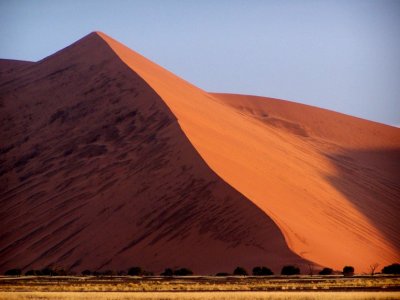




Namibia's name was derived from Namib desert, which is believed to be the oldest desert in the world. This unique geological feature is renowned for the pristine and haunting quality of its landscape. It's this feature that characterizes the country most, and is home to some of the country's top tourist destinations, notably Sossusvlei, Sandwich Harbour and the Skeleton Coast Park.
Far from being lifeless and barren, the desert features an unusual variety of desert-adapted flora and fauna, including a large number of endemic plant, bird, reptile and insect species. Many of these species are of particular scientific interest and attract scientists from all over the world.
CAPITAL: Windhoek
CLIMATE: Namibia has a dry climate typical of a semi-desert country where droughts are a regular occurrence. Days are mostly warm to very hot, while nights are generally cool. Average day temperatures in the summer vary from 20°C - 34°C and average night temperatures in the winter vary from 0°C - 10°C. There are vast differences between the arid southern desert and semi-desert areas and the tropical north-east with its abundant summer rains. The best time to visit Namibia is Apr-Oct.
CURRENCY: 1 Namibia Dollar = 100 cents. Rands are accepted as legal tender. Traveller's cheques are accepted almost everywhere. German Marks, USD or Swiss Franc traveller's cheques are recommended. In general, credit cards are accepted by most hotels as well as in Namibia Wildlife Resorts where MasterCard, Visa, (Diners Club and Amex not always), Namibian Dollars, Rand traveller's cheques and bank guaranteed cheques are accepted. Credit cards aren't accepted for fuel.
ELECTRICITY: 220 volts, 50Hz. Plugs are 3-pin round.
HEALTH: A yellow fever vaccination certificate is required from travellers over 1 year of age coming from infected areas. Visitors are advised to take pre-arrival precautions against malaria (risk exists Nov-Jun in the northern regions such as Ovamboland and the Caprivi Strip as well as in Omaheke and Otjozondjupa and throughout the year along the Kavango and Kunene rivers), hepatitis A, polio and typhoid. Tap water is safe.
LANGUAGE: English is the official language. In shops, hotels and restaurants, Afrikaans and German are often spoken.
PUBLIC HOLIDAYS: New Years' Day (1 Jan); Independance Day (21 Mar); Good Friday (9 Apr); Easter Monday (12 Apr); Labour Day (1 May); Cassinga Day (4 May); Ascension Day (20 May); Africa Day (25 May); Heroes Day (26 Aug); Goodwill Day (7 Oct); Human Rights' Day (10 Dec); Christmas Day (25 Dec); Boxing Day (26 Dec).
SHOPPING: woodcarvings; basketry; pottery; fur coats & jackets, especially Swakara; gold jewellery; individually-designed hand-woven carpets and wall hangings made from karakul wool; Namibian semi-precious stones and diamonds; Herero dolls.
SOCIAL CONVENTIONS: There is a Christian majority. Western customs and courtesies are observed. Business suits are worn in winter; in summer, safari suits are acceptable.
TIME DIFFERENCE: GMT +2 (GMT +1 during Apr-Aug)
TIPPING: 10 percent of the bill is customary.
TOP TEN ATTRACTIONS DESCRIPTION:
Windhoek:
The capital; a small, bustling city with a 'continental' atmosphere; many sights including the Gibeon Meteorite Fountain, National Art Gallery of Namibia, Tintenpalast, Namibia Craft Centre and National Botanical Garden; shopping.
Fish River Canyon:
One of Namibia's most spectacular geological phenomena; contains Ai-Ais Hot Springs, rugged mountainland, Fish River Canyon (second largest gorge in Africa) and Huns Mountains with isolated and otherworldly landscape and wealth of interesting xerophytic plants; seasoned hikers regard the 4-5 day trail as one of southern Africa's major challenges.
Sossusvlei-Namib:
Naukluft Park Monumental dunes lie at the end of an erosional trough formed by the Tsauchab River; they are star-shaped.
Etosha National Park:
Namibia's first conservation area and one of the largest game reserves in Africa; its definitive feature is the Etosha Pan, a vast shallow depression of approx. 5000km²; elephants here are reputed to be of the largest in Africa; of the 114 mammal species found in the park, several are rare and endangered; bird life is interesting during rainy season.
Skeleton Coast Park:
An aura of mystery and impenetrability surrounds this park with its many shipwrecks, dense coastal fogs and cold sea breezes; of special interest are the clay castles of the Hoarusib, the salt pans near Agate Mountain, the seal colony at Cape Frio and the remains of shipwrecks along the coast.
Caprivi Strip:
Lush riverine forests and seasonal flood plains; some of southern Africa's top birding spots, especially the Caprivi Game Park; known also for its arts and crafts e.g. pots and baskets with their distinctive beauty and symmetry; shop at Lizauli Traditional Village and variety of craft centres; other activities include angling e.g. tiger fishing and game viewing on boat cruises.
Luderitz-Kolmanskop:
Namibia's most famous Ghost Town, situated in the Sperrgebiet approximately 10km from Lüderitz; the museum recounts the history of this abandoned mining community.
Swakopmund:
Popular because of its old-world charm and relaxed atmosphere; distinct German colonial character; historical buildings and modern aquarium; renowned for kudu leather shoes.
Cape Cross Seal Colony:
Home to the biggest and the best-known of the 223 colonies of Cape fur seals which breed along the coast of South Africa and Namibia; during Nov/Dec breeding season as many as 150,000 seals gather here; off the coast are protected bird islands.
Epupa Falls:
One of Namibia's prime tourist spots; a series of cascades where the Kunene River drops 60m over a distance of about 1,5km, dividing into a multitude of channels and forming a myriad rock pools; it is possible to swim in these pools, but keep a lookout for crocodiles.
Gerald Crawford was born in South Africa, studied electronics, telecommunication, eco-travel and african travel concepts. He taught responsible tourism in South Africa. If you have any questions or comments please e-mail me on. E-mail Address: southafricantravelarticles@12234455.co.za Website Address: www.12234455.co.za
Article Source: http://EzineArticles.com/?expert=Gerald_Crawford